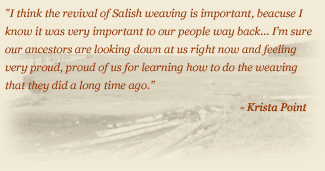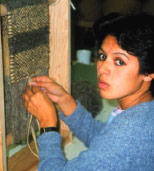

My name is Krista Point. I am a Coast Salish weaver and a member of the Musqueam Nation. My husband Craig Antoine is a carver. I have three daughters, Sherry, Deanna and Angela.
When I was nineteen, I was accepted into the first Salish Weaving School at Musqueam in 1983. Wendy John was our instructor. She took a weaving course herself, and then shared the knowledge she had gained with eight of us ladies. I am very grateful to her for teaching me to weave. I wouldn't be where I am today if she didn't start the weaving school.
I still weave shawls and blankets for people who use them for ceremonial purposes. In 1995, I made one for my cousin to wear when she got married the traditional way. In 1996, I completed a major five by sixteen-foot weaving for the Vancouver International Airport, in the International Arrivals terminal [weaving left]. My weavings have been included in several art shows, along with the work of my aunt Susan Point, who is also a Coast Salish artist. She kept me going, actually. She was very happy that I was doing our Salish weaving.
I think the revival of Salish weaving is important, because I know it was very important to our people way back. Before I started in the school, I didn't know that Musqueam had a tradition of weaving. The only art that I knew of was basketry because my great-grandma, my grandma, and my mom used to do baskets. Our culture has been lost for so many years and it's good for us to learn about our past, to teach younger generations to carry it on. I'm sure our ancestors are looking down at us right now and feeling very proud, proud of us for learning how to do the weaving that they did a long time ago. I'm still learning, but it makes me very proud to be able to do this. I love it.
For a lot of the work I do, I go from the old blankets. I combine and personalize the designs to make them different than the old ones. The designs that I use represent Musqueam people. These designs are an accumulation of various weavings that I have done over the years. The weavings that I have done are with traditional designs, which come from old blankets and baskets. I like the zig-zag design. It has several interpretations, including a trail or snake, and lightning. The design has a lot of strength and power. I use the Salish butterflies on most of my weavings, as well as the double arrowhead, the checkerboard pattern and the herringbone pattern.
When we were in the weaving school, we learned how to dye using natural plants like lichen, stinging nettles, dandelions, horsetail, and onion skins. That was fun because we did a lot of experimenting. Some of the colors we'd come out with were just gorgeous. We recorded them on paper. I have kept a record of all the colors that I have used, right from when I first started. The first dye I did was on November 14, 1983. I used onion skins to make a yellow colour.
Today, I use a combination of natural and chemical dyes for my weavings. Yellow can be achieved using onion skins, dandelions, and goldenrod flowers. Green is dyed with stinging nettles, horsetail, and red onion skins. Red alder bark makes a nice red dye. The goldish beige colour is from lichens. I'm still experimenting with dyes. I know that to achieve some colours, you have to go right to the root of the plant. For example, when you dye with dandelions you've got to take the whole root and the flower out. If I can't get a colour naturally, like if it's out of season because you have to pick certain plants in spring, then I just use a commercial dye from the store.
In the spring, you can collect things like horse's tail, stinging nettles, and dandelions. With the stinging nettles, I pick them and then I put them in the freezer, and just take them out when I need them. I go into schools and do presentations. I show pictures of the way they used to spin the wool with spindle whorls. I show them how today I use my pedal spinner. They say I make it look so easy. I told them that it comes with many years of practice, that it wasn't like this to start, and I'm actually still working on getting it perfect.
This is the first weaving that I did with a design in it [weaving on previous page]. We had to give our first weaving away that we made; it's a tradition. So after the weaving school ended, we decided to give our weavings away to Musqueam Chief and Council at a ceremonial dance down at the longhouse. We put all their names in a hat, and then we all picked names of who we were going to give to. My dad was on council at the time, and I got his name, so he got my first weaving and we still have it. I love weaving; it relaxes me. I know that when I weave I have to be by myself, and I listen to music. When someone comes and interrupts me, I can't just sit down and continue to weave, because I lose my concentration. With new ideas in my head, I get excited enough to sit down and get busy again.
› View Krista Point's Image Gallery




